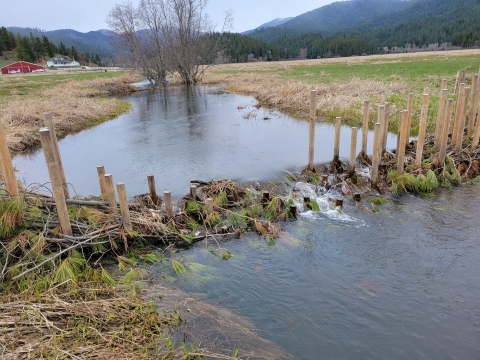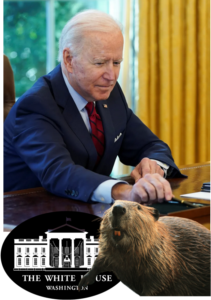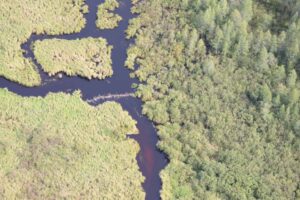Leave it to Beaver: Partners Collaborate on Beaver Dam Analog Project
Mimicking Mother Nature for Maximum Impact with Minimal Financial and Environmental Cost
By Amanda Smith
“One plus one plus one equals six on this project,” said Kat Hall, restoration manager for The Lands Council, an environmental non-profit organization that seeks to preserve and restore Northwest ecosystems through partnerships.
The excitement is evident in Hall’s voice as she speaks about an innovative and collaborative effort to reconnect and restore aquatic habitat in Thompson Creek, a primary tributary to Newman Lake located northeast of Spokane, Washington. For the past 3 years, Hall has been part of what she calls “a dream team” of federal, state, and local partners to design, implement, and monitor beaver dam analogs (BDAs), human made structures inspired by nature’s busiest builder that efficiently improve the health of aquatic ecosystems.
Historically, Thompson Creek meandered through the lower watershed; but over a century ago, it was straightened to accommodate for agriculture, helping to reduce flooding for farmers. While the straightened channel was beneficial to the farmers, it had less desirable impacts on watershed health. The straighter, less natural flow path increased the speed of the water, led to the erosion of the bank, and transported more sediment and pollutants downstream into Newman Lake. This incision of the creek has also caused a disconnection between the creek and its surrounding floodplains, which has allowed for the dominance of reed canary grass in the area, a non-native species that outcompetes more diverse and beneficial vegetation.
![]() There doesn’t seem to be much food to entice beavers yet and that might be good for awhile due to the current poor water quality!:
There doesn’t seem to be much food to entice beavers yet and that might be good for awhile due to the current poor water quality!:
“One of the primary concerns about straightening the channel and disconnecting it from its floodplain is the increased phosphorous levels we are seeing as a result,” explained Brian Walker, a private lands biologist with the U.S. Fish and Wildlife Service (Service). “Phosphorous travels with the sediment through Thompson Creek and ends up downstream in Newman Lake, which really impacts the water quality in the lake.”
While phosphorus is a naturally occurring and essential nutrient for plants and animals, too much of it can cause explosive growth of aquatic plants and algae. This can lead to a variety of water quality problems, including low dissolved oxygen concentrations, which can cause fish kills and harm other aquatic life. The major concern with phosphorus in Newman Lake is a toxic blue-green algae bloom that can cause the lake to be closed to recreation and private landowners (see a write-up from USGS on phosphorus and water quality).
“High levels of phosphorous are detrimental to both people and wildlife — just a couple licks of contaminated water can be lethal for pets; it’s pretty bad stuff,” said Walker. “But thankfully, we people are learning how to mimic wildlife to come up with a solution for us all!”
Improving Thompson Creek has long been a goal, and several time consuming and costly measures have been implemented in the past with varying degrees of success.
“We weren’t getting the results we hoped for from other projects and we needed to go in a different direction; we needed to get creative,” said Walker.
Inspiration struck in the form of brown fur and bucked teeth — beavers. Like ecosystem engineers, beavers manipulate their environment by building dams that slow the passage of water through a river and can act as a natural filter that cleans the water supply. Beaver dam analogs aim to do the same thing through creating roughness — think speed bumps — to slow water velocity and allow sediment and pollutants to settle. The beaver dam analogs will also raise the water level of Thompson Creek, reconnecting it to its floodplain and allowing for the growth of more natural vegetation to create a healthier ecosystem.

“The Partners for Fish and Wildlife Program has had success with at least 20 BDAs in other Washington watersheds and, with the help of our “dream team,” we knew our odds of making positive change in Thompson Creek were high,” Walker said.
The “dream team,” compromised of partners from every level — The Lands Council, Partners for Fish & Wildlife Program at Turnbull National Wildlife Refuge, Gonzaga University, Spokane Conservation District, Newman Lake Property Owners Association, and Spokane County — got to work in 2019 and began making the beaver dam analogs in Thompson Creek a reality.















































